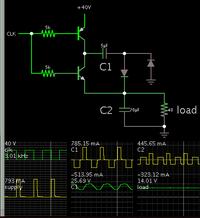JohnJohn20
Advanced Member level 4
Hi. I want to regulate a 45VDC unregulated power supply down to 300mA at ~12V. I was going to use a LM7812 until another member pointed out they have a max Vin of 35V. My plan was to use the circuit shown on the right:

The LM7812 datasheet says:
30. CI is required if regulator is located an appreciable distance from power supply filter. In my case the main rectifier bridge and capacitor are less than 100 mm from the regulator.
31. CO improves stability and transient response.
Would it help to include capacitors like this?
Are there any other tricks to make this regulator give a smooth DC voltage when the input voltage can vary from 32 V - 45 V (due to factors like switched high current loads up to about 15A) and is quite likely to have spikes and ripples?
Thanks. Chris.

The LM7812 datasheet says:
30. CI is required if regulator is located an appreciable distance from power supply filter. In my case the main rectifier bridge and capacitor are less than 100 mm from the regulator.
31. CO improves stability and transient response.
Would it help to include capacitors like this?
Are there any other tricks to make this regulator give a smooth DC voltage when the input voltage can vary from 32 V - 45 V (due to factors like switched high current loads up to about 15A) and is quite likely to have spikes and ripples?
Thanks. Chris.
